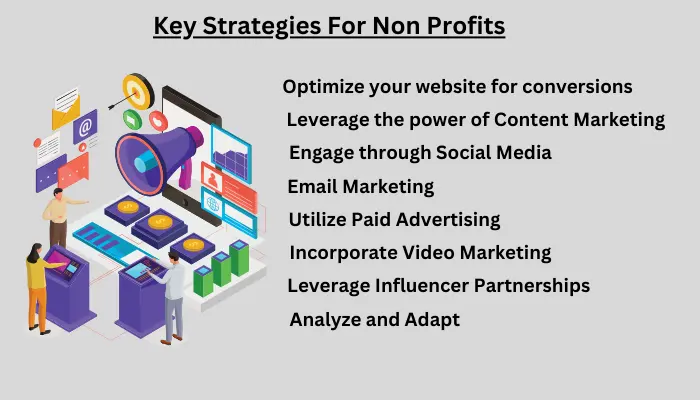
In the dynamic landscape of today’s digital world, nonprofits face unique challenges and opportunities. To thrive, these organizations must harness the power of digital marketing to boost awareness and foster donations. This extensive guide explores the multifaceted strategies that can empower nonprofits to achieve their mission through the digital realm.
In an era where information is primarily disseminated through digital channels, nonprofits must embrace digital marketing to ensure their messages reach their intended audience. Digital marketing offers a cost-effective, scalable, and measurable way to promote causes, engage with supporters, and raise funds. Unlike traditional marketing, digital marketing allows for real-time interaction with stakeholders and provides data-driven insights to tailor strategies for maximum impact.
Read more: Subscription Based Models in E-commerce Building Loyalty And Recurring Revenue
1. Optimize Your Website for Conversions
Your website is often the first point of contact between your nonprofit and potential supporters. It’s crucial to optimize it not only for user experience but also for conversions. This means having a clear call-to-action (CTA), an easy donation process, and mobile responsiveness. Use compelling storytelling to connect with visitors, showcase the impact of donations through stories and visuals, and ensure the navigation is intuitive.
2. Leverage the Power of Content Marketing
Content marketing is a powerful tool for nonprofits to engage with their audience by providing valuable and relevant content. This could range from blog posts, infographics, and videos to podcasts that highlight success stories, discuss relevant issues, and share insights into your nonprofit’s work. By optimizing content for SEO, you can improve your website’s visibility on search engines, making it easier for potential supporters to find you.
3. Engage Through Social Media
Social media platforms offer a unique opportunity for nonprofits to engage directly with their audience. By creating compelling and shareable content, you can increase your reach and drive engagement. Platforms like Facebook, Twitter, Instagram, and LinkedIn allow you to share updates, run campaigns, and even facilitate donations directly through the platforms. Remember, consistency and authenticity are key to building a strong social media presence.
4. Email Marketing for Personalized Communication
Email marketing remains one of the most effective digital marketing strategies for nonprofits. It allows for personalized communication with supporters, keeping them informed about your work, upcoming events, and how their contributions are making a difference. Segment your email list to tailor messages for different groups, such as one-time donors, recurring donors, and potential donors, to increase the relevance of your communications.
5. Utilize Paid Advertising
While organic reach is important, paid advertising can significantly amplify your nonprofit’s visibility. Platforms like Google Ad Grants offer nonprofits the opportunity to run ads on Google at no cost. These ads can increase website traffic and drive specific actions, such as donations or event registrations. Facebook and Instagram also offer powerful targeting options to reach potential supporters based on their interests, behaviors, and demographics.
6. Incorporate Video Marketing
Videos are a compelling way to tell your nonprofit’s story, showcase your impact, and connect emotionally with your audience. They can be used across your website, social media platforms, and email campaigns. From short social media clips to longer documentary-style videos, this format can significantly increase engagement and encourage shares, expanding your reach.
7. Leverage Influencer Partnerships
Partnering with influencers who align with your nonprofit’s values can help extend your reach to a broader audience. Influencers can share your content, participate in campaigns, and even help fundraise, leveraging their followers to increase awareness and support for your cause.
8. Analyze and Adapt
Digital marketing offers the advantage of being highly measurable. Use analytics tools to track the performance of your marketing activities, understand what resonates with your audience, and identify areas for improvement. Regularly reviewing your strategies and adapting based on data insights is crucial for ongoing success.
Also Read: Web 3.0-and Marketing Embracing the Decentralized Internet For Business Growth

While digital marketing offers numerous opportunities for nonprofits, it also comes with challenges, such as limited resources and the need for digital skills. To overcome these, nonprofits can leverage free tools and platforms, seek partnerships, and invest in training for staff. Prioritizing and focusing on strategies that offer the highest return on investment can also help maximize impact.
Conclusion
Digital marketing is not just a tool for businesses but a vital strategy for nonprofits looking to make a difference in the world. By effectively utilizing digital marketing strategies, nonprofits can drive awareness, engage with supporters, and increase donations. From optimizing your website for conversions to leveraging social media and email marketing, each strategy plays a crucial role in building a strong digital presence. Remember, the key to success lies in being authentic, adaptable, and data-driven. As digital landscapes evolve, so too should the digital marketing strategies of nonprofits, ensuring they continue to connect with their audience and achieve their mission.
Recent Posts
Categories
Our Address:
2nd Floor, H-187, Block – H, Sector 63, Noida, Uttar Pradesh 201301, India
Phone: +91-8882811078
Email: hello@digidiracademy.com
©2025. DigiDir Academy, Digital Marketing Training in Noida. All Rights Reserved.
You can see how this popup was set up in our step-by-step guide: https://wppopupmaker.com/guides/auto-opening-announcement-popups/